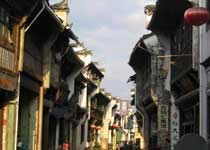Attration Category
Huangshan Weather

An ancient Western-European architect once visited the old street and said that he had found "The Eastern Ancient Rome."
First built over 700 years ago, during the Song Dynasty (960-1279), the street is flanked by some buildings from this period. More noticeable are the buildings from the Ming and Qing Dynasties (1368-1911), during which time the "Tunxi Ancient Street" became a distribution center for goods and materials to Huizhou.
The shops, workshops and residences have continued to maintain the characteristics and operational layout of ancient stores such as "shop in the front and workshop or house in the back".
Most of the buildings are only three stories high, stone-based and brick-laid. They are decorated with small green tiles, wood carvings in the Hui style, ancient shop signs, and red-lacquered with double eaves on the roofs. They are simple and elegant, magnificent and clean.
The pavement is 5 to 8 meters wide, laid with large red flagstones. Whether you are wandering along the old bridge, visiting the fish beside the river, finding shoots of bamboo on the slope, or standing under a tree and listening to the birds whistle, it is easy to rest and attain mental tranquility by getting back to the nature.
Shops and stalls sell an interesting mix of antiques and knick-knacks including ink stones, brushes, local teas, Mao badges and advertising posters from the 30s.
There are also many small food vendors and some excellent dumpling restaurants.
The shop names in the ancient street have a lot of culture meanings, which shows that the merchants in Huizhou are scholar-merchants. Many of these shops carry more than a hundred years of history, such as "Tongderen" (Medicine Shop), "Tonghe" (Steelyard Store), and "Chengdexin" (Sauce and Pickle Shop).
These stores continue to use the same methods of production, display, and operation as they did in ancient times.


